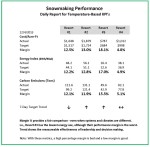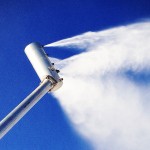Why SEI? Maximizing snow production while minimizing expenses is critical to a ski resorts bottom line. More than any other department, snowmaking spends the most money in the shortest time period. Optimization of the snow production process is essential for accountability of the process. To effectively accomplish this requires information management tools. They are obtained from an operational metric called SEI. What is SEI? The Snowmaking Energy Index is a performance measurement metric for the entire snowmaking process. The variables of energy use and water flow (snow) are compared to wet bulb temperature. This calculation results in an … [Read more...]
Snowmaking with Artificial Intelligence
While automatic snow guns are a common component of the snowmaking process, artificial intelligence goes much further to include all of the machine rooms, pump stations, weather stations, water cooling and utility grids. Additionally, AI will be making the decisions on when and where to make snow. Automated decision making will also integrate skier patterns, skier numbers, weather forecasts, budgets, energy costs and snow depth data from the grooming fleet and drones. In the near future, labor will be cut by 70% and there will be two SCADA Technicians on every shift. AI does not mean that snowmaking will be unattended. Mountain managers will … [Read more...]
Snowmaking Analytics
This PowerPoint presentation shows all levels of managers how to measure snowmaking performance. Click on Snowmaking Analytics to see the PowerPoint presentation. Click Slide Show tab, then From Beginning and the slides will play automatically. Use arrow keys to navigate as needed. From this presentation you will see why these analytics are the most powerful tools in snowmaking. These management methods have been used in industrial processing for decades. We have adapted them to measure snowmaking performance. With these analytics, managers are empowered with Key Performance Indictors (KPI’s) that insure maximum snow production and … [Read more...]
True Cost of Labor Savings
This time of year many resorts are reducing the size of snowmaking staff. Most Managers believe this is smart business because less labor cost means less operating expense and more profit. Reality is that decisions to reduce labor can actually cost the company more money, not less. The reason is because wages are only part of the equation for making snow. Energy, time and temperature must also be calculated into the cost to produce an Acre-foot of Snow. Case Study KPI’s from a mid-sized ski resort are shown in the chart. Costs for labor, energy and water are correlated to temperature to show the Cost/Acre-foot of Snow. The curve for Phase … [Read more...]
The Future of Snowmaking – Asset Utilization
Automation and water storage are the obvious future, but until a ski resort can invest millions of dollars, the near-future is about utilizing existing assets. And this is accomplished with business analytics that identify, measure and improve operational performance. Business Analytics for Snowmaking Every aspect of business is scrutinized with analytics that identify profit (productivity) margins. Reality is that maximum snow production remains unidentified and unmeasured, thus assets and technology are underutilized. The main reason is because of poor accounting methods. Snowmaking is typically managed from the top-down with allocated … [Read more...]
Compare Performance Margins
Managers of multiple resorts regularly compare the performance of each location. This is common place for profit margins in retail, rental and food service, although methods that fairly compare snowmaking performance (profits) seldom exist. The reason is because of variables with temperatures and equipment. The good news is that our analytics use accounting methods which standardize all operational variables and report performance (profit) margins. These bottom-up KPI’s allow managers to compare snowmaking performance at multiple resorts, even when there is a difference with temperatures, snow guns, run times and labor. The chart below … [Read more...]
ID and Measure Optimal Snow Production
Best Practices - It is easy to see that low-e equipment has reduced the amount of energy used in the snowmaking process. Essentially, the industry is making more snow with less energy. The cost per unit of production is less and this is good for the bottom line of business. To improve on the situation, managers must also recognize that lots of energy and money is still being left on the table. More importantly, wasted energy means less snow production - and every resort wants more snow. The good news is that reporting tools are available to identify and measure optimal productivity. The dashboard below shows precisely what costs … [Read more...]
Next Level of Efficiency
Best Practices - Now that most snowmaking systems are upgraded with the resources of low-e snow guns, automation, VFD's and better compressors; managers are in search of the next level of efficiency. Reality is that all of this equipment, including automation, needs human resources to operate it at best production. Therefore, the next level comes from maximizing performance of the human resources. To insure maximum performance requires a standard or benchmark to measure against. Once the benchmark is established, actual operations are compared to it and the differentials are reported as productivity margins. These KPI's measure how … [Read more...]
KPI’s for Senior Managers
Best Practices - Since most resort managers come from a background in business finance, understanding the industrial process and KPI's of snowmaking can be a mystery. The good news is metrics are available that quantify snowmaking performance with the same accounting methods as financials. Percentage Margins Similar to revenue producing departments like retail, the snowmaking process also measures performance with percentage margins. In both applications, the metric uses a benchmark with actual performance (or profit or productivity) measured against it. The differential is expressed as a percent. Below is an example for 12 hours of … [Read more...]
Test 1
Lorem ipsum dolor sit amet, consectetur adipisicing elit, sed do eiusmod tempor incididunt ut labore et dolore magna aliqua. Ut enim ad minim veniam, quis nostrud exercitation ullamco laboris nisi ut aliquip ex ea commodo consequat. Duis aute irure dolor in reprehenderit in voluptate velit esse cillum dolore eu fugiat nulla pariatur. Excepteur sint occaecat cupidatat non proident, sunt in culpa qui officia deserunt mollit anim id est laborum. Lorem ipsum dolor sit amet, consectetur adipisicing elit, sed do eiusmod tempor incididunt ut labore et dolore magna aliqua. Ut enim ad minim veniam, quis nostrud exercitation ullamco laboris nisi ut … [Read more...]






